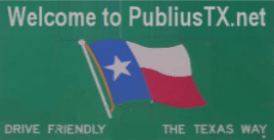Rob Booth pulls this bit out of a Comical Q&A on light-rail:
How many people are expected to ride?
For all the hoopla, few Houstonians are expected to commute on the electric-powered trains. Metro has estimated daily ridership after the first year at 33,000, which translates into 16,500 people making roundtrips. That’s not even 1 percent of the city’s population.
Opponents fought the rail line every step of the way, decrying it as nothing more than an expensive toy that takes money away from highways. But supporters are optimistic that rail holds the potential to reshape the city and its ugly image, hoping the tracks attract hundreds of millions of dollars in new apartments, townhomes, restaurants, stores and office towers inside the Loop.
Funny, but I remember all the rail proponents telling us this was a plan actually to reduce congestion, while those of us opposed to the cost of the thing pointed out that it wouldn’t reduce congestion significantly, that there were less expensive/more efficient mass-transit options, and that light-rail was largely a boondoggle for developers and people who wanted to reshape Houston into their vision of a “world-class city.”
It looks like we opponents were right, if I’m reading light rail’s biggest cheerleader (the Comical) correctly. They didn’t admit any of this before the voting, of course.
Here’s another fun answer:
Where are there likely to be trouble spots?
The train travels at street level for its entire route, crossing dozens of intersections. Most are controlled by standard traffic lights, but there are railroad crossing gates and flashing lights at major locations.
Tom Lambert, Metro police chief, said troublesome areas include five intersections in the Texas Medical Center where cars must drive on the train tracks to make a left turn; the intersection of Main and Richmond, where the tracks turn from a protected area onto Main; and at the South Loop frontage road, which is the highest-speed road crossed by the train and also where the overhead wires dip below 15 feet, requiring a detour for tall trucks.
It would have been easier and just as accurate to write “There are likely to be trouble spots along the whole line.”
Putting rail at street level and mixing it with motor traffic creates a more dangerous situation for motorists. Period.

1 comments On The Rail Boondoggle – cont’d
Time for me to pipe up again…
1. To judge by your earlier posts, land use planning in the Greater Houston area sucks eight inches. This does not help rail’s ability to play nicely with the rest of infrastructure.
2. Texas is one of those places where vehicle ownership and use is considered a prerequisite for being treated like a responsible adult by the ommunity.
3. Even if 2. above weren’t true, the rail system would need to provide an attractive alternative to operating a private automobile for at least some trips. That means high frequencies and stops that are well-placed. I don’t see that happening in this case.
4. If I read it right, there are crossings on the route that are neither guarded nor signalled to that the trains are guaranteed the right of way (as is the case with all of the crossings in Portland). If true, I want some of the drugs that that decisionmaker was smoking.
Comments are closed.